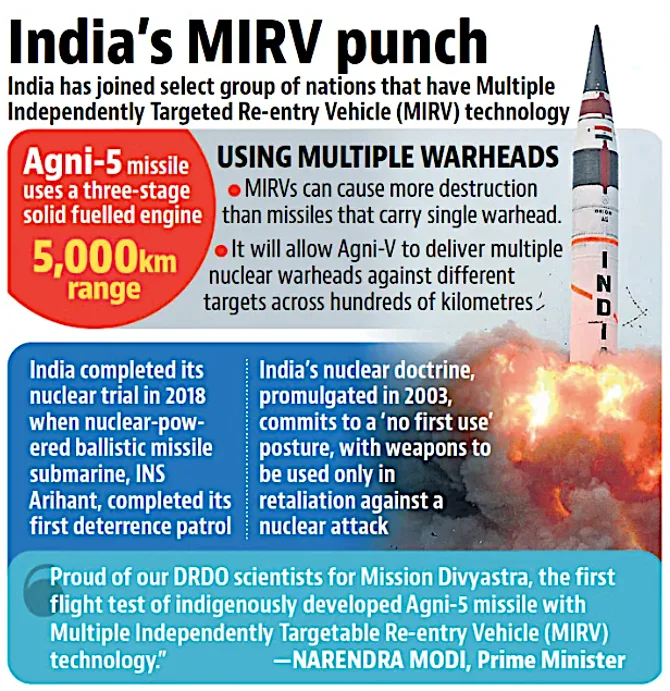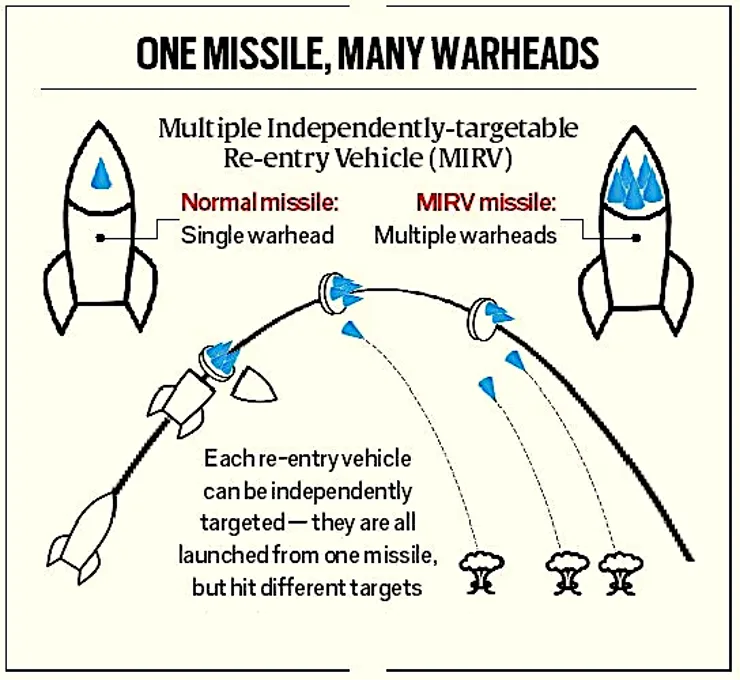What’s in this Article?
- Table of Contents
- Why in the News?
- Mission Divyastra
- About MIRV Technology
- MIRV Technology is New to India
- IGMDP
- Agni Ballistic Missile System
- About Agni-5 Missiles
- Challenges in MIRV Development in India
- Conclusion
- FAQs
- MCQs
Why in the News?
- On March 11, Prime Minister Modi announced the successful flight test of an Agni V ballistic missile with Multiple Independently targetable Re-entry Vehicle (MIRV) technology.
- The Defence Research & Development Organisation (DRDO) successfully conducted Mission Divyastra, a maiden test flight of the nuclear-capable Agni-V with the Multiple Independently Targetable Reentry Vehicle (MIRV).
- The test flight, dubbed Mission Divyastra, marked the first time the technology was tested, which aims to deliver multiple warheads on a target in a single launch, giving India a unique ability in strategic defence of its boundaries.
- “Proud of our DRDO scientists for Mission Divyastra, the first flight test of indigenously developed Agni-5 missile with Multiple Independently Targetable Re-entry Vehicle (MIRV) technology,” Prime Minister Narendra Modi said in a post.
Mission Divyastra–
- The DRDO‘s triumphant execution of Mission Divyastra signals a major milestone in India’s nuclear prowess.
- It denotes the first-ever flight trial of the indigenous Agni-5 nuclear missile, boasting a range of 5,000 kilometers and equipped with MIRV technology.
- Conducted from Dr APJ Abdul Kalam Island along the Odisha coastline, this test showcases the capability of the missile to deploy numerous warheads to different or identical destinations in a solitary launch, potentially incorporating decoys to confuse adversary ballistic missile defenses.
About MIRV Technology
- The inception of MIRV (Multiple Independently Targetable Re-entry Vehicle) technology was marked by the United States’ successful test of the Minuteman III in 1968, which introduced this game-changing capability into actual use by 1970.
- MIRV technology had its roots in the United States when a MIRVed Intercontinental Ballistic Missile (ICBM) was first deployed in 1970.
- This innovation enables a single missile to accommodate multiple warheads (typically 4-6), each with the capability to target distinct locations autonomously. By doing so, MIRV technology amplifies the effectiveness of the missile by broadening the array of potential targets it can engage.
- Moreover, MIRVs are deployable from both land-based and sea-based platforms, including submarines, thereby broadening their operational versatility and reach.
Global adoption and dissemination
- The origins and development of MIRV (Multiple Independently Targetable Re-entry Vehicle) technology represent a significant chapter in the history of ballistic missile systems.
- American Developments: The United States played a pioneering role in the development of MIRV technology. In the late 1960s, the U.S. Air Force initiated several MIRV development programs, including the LGM-118A Peacekeeper (MX) missile program. The Peacekeeper missile, deployed in 1986, was capable of carrying up to ten independently targetable warheads.
- Soviet Response: As the United States progressed with its MIRV programs, the Soviet Union responded with its own efforts to develop MIRVed ballistic missiles. The Soviet R-36 (SS-18 Satan) missile, deployed in the 1970s, became one of the most well-known MIRVed systems in the Soviet arsenal.
- Technological Challenges: Developing MIRV technology posed significant technological challenges, including miniaturizing nuclear warheads to fit multiple reentry vehicles onto a single missile, ensuring accurate targeting of each warhead, and managing the complexities of launching and controlling multiple independent reentry vehicles.
- Strategic Implications: The development of MIRV technology had profound strategic implications. It allowed both the United States and the Soviet Union to enhance the survivability, flexibility, and potency of their nuclear arsenals. MIRVed missiles could target multiple enemy locations with a single launch, increasing the destructive potential of each missile.
- (Multiple Independently Targetable Re-entry Vehicle) The proliferation of MIRV technology raised concerns about arms control and stability. The ability of MIRVed missiles to saturate enemy defenses and strike multiple targets heightened fears of a destabilizing arms race and increased the risks of accidental or unauthorized nuclear use.
- Evolution and Proliferation: Over time, MIRV technology continued to evolve, with advancements in guidance systems, warhead design, and delivery platforms.
- Nations possessing MIRV technology include major nuclear powers such as the United States, the United Kingdom, France, Russia, China, and India, while Pakistan tested the technology (Ababeel Missile) in 2017.
MIRV Technology is New to India
- India has joined a very select group of countries (United States, the United Kingdom, France, Russia, China) to develop an MIRV ballistic missile.
- The inaugural test flight of Agni-5 saw India experimenting with MIRV technology for the first time, intending to deploy multiple warheads to various locations in one launch.
- The Agni-5 armament boasts native avionics systems and precise sensor packages, guaranteeing the re-entry vehicles’ arrival at target points with exceptional accuracy.
- Acts as a Deterrent: India’s integration of multiple warheads onto the Agni-5 restores balance in the Sino-Indian nuclear deterrent relationship.
- Example- China is developing ballistic missile defences like the HQ-19 interceptor, but their effectiveness against IRBMs like India’s Agni-5 is uncertain.
Agni Ballistic Missile System
- The first missile of the series, Agni-I was developed under the IGMDP and tested in
- The Agni missile family consists of four deployed variants, i.e. Agni-I, Agni-II, Agni-III and Agni-IV are already in service with the Indian Army.
- Agni-V was successfully test-fired in December,
- All Agni missiles are nuclear-capable ballistic missile system.
Integrated Guided Missiles Development Programme (IGMDP)
- IGMDP was a Ministry of Defence programme for the research and development of the comprehensive range of missiles.
- The project started in 1982–83 under the leadership of Dr APJ Abdul Kalam who oversaw its ending in 2008 after these strategic missiles were successfully developed.
- Nodal agencies: DRDO and Ordnance Factories Board
The 5 missiles developed under this program are:
- Prithvi: Short range surface to surface ballistic missile
- Trishul: Short range low level surface to air missile
- Nag: Anti-tank guided missile
- Akash: Medium range surface to air missile
- Agni: Surface to surface ballistic missiles with different ranges
List of Agni missiles with their range
- Agni-I: 700-800 Km
- Agni-II: 2000 Km
- Agni-III: 3000 Km
- Agni-IV: 4000 Km
- Agni-V: 5000 Km
- The Agni-V is an Intercontinental Range Ballistic Missile (ICBM) with three solid fuel stages.
About Agni-5 Missile
- The Agni-5 missile is a long-range ballistic missile developed by the Defence Research and Development Organisation (DRDO) of India. It is the most advanced missile in the Agni series, which is part of India’s Integrated Guided Missile Development Program (IGMDP).
- Range: Agni-5 is an intercontinental ballistic missile (ICBM) with a range capability of over 5,000 kilometers (3,106 miles). Some reports suggest that it has a range of up to 5,500 to 5,800 kilometers.
- Payload Capacity: It is designed to carry a payload of about 1,500 kilograms (3,307 pounds), which enables it to carry both conventional and nuclear warheads.
- Launch Platform: Agni-5 can be launched from multiple platforms, including road mobile launchers and rail mobile launchers. This mobility adds to its strategic flexibility and survivability.
- Propulsion System: The missile is propelled by a three-stage solid fuel rocket motor. Solid fuel propulsion provides quick launch capabilities and enhances the missile’s readiness.
- Accuracy: Agni-5 is equipped with advanced navigation systems and guidance systems, including an indigenously developed Ring Laser Gyroscope (RLG) and a Micro Navigation System (MINS). These systems enable the missile to achieve a high degree of accuracy, reportedly with a Circular Error Probable (CEP) of less than 10 meters.
- Dimensions: The Agni-5 missile has a length of about 17 meters (56 feet) and a diameter of 2 meters (6.5 feet). Its large size accommodates the necessary fuel and payload for its long-range capabilities.
- Technology: Agni-5 incorporates advanced technologies like MIRV developed by DRDO, including composite rocket motor casing technology, which helps reduce weight and enhance performance.
- Strategic Significance: Agni-5 significantly enhances India’s strategic deterrence capabilities by providing the ability to strike targets across long distances with precision. It strengthens India’s nuclear triad, which comprises land, air, and sea-based nuclear delivery systems.
- Test Flights: The Agni-5 has undergone several successful test flights since its first launch in 2012. These tests have demonstrated its operational readiness and performance capabilities.
- Agni-V was successfully test-fired in December, 2018.
- Strategic Implications: The development and deployment of Agni-5 reflect India’s efforts to modernize its military and enhance its deterrence posture against potential adversaries. It also underscores India’s indigenous missile development capabilities and self-reliance in defense technology.
Obstacles/Challenges Encountered in MIRV Development in India
- New Delhi’s insufficient nuclear testing compromised its ability to downsize warheads and equip them for Multiple Independently Targetable Reentry Vehicle (MIRV) deployment.
- The lack of comprehensive testing undermined the potential design sophistication of re-entry vehicles for carrying warheads.
- DRDO’s Endeavors: DRDO, along with its pivotal affiliates like the Terminal Ballistics Research Laboratory (TBRL) for warhead-missile integration and Advanced Systems Limited (ASL), as evidenced by the Agni-5 test, have surmounted these hurdles effectively.
Future Ventures/Projects
- Targeting China with MIRV Capability: Agni-5 faces a threat from Chinese missile defense interceptors, which could intercept it mid-flight.
- The Bhabha Atomic Research Centre (BARC), overseen by the Atomic Energy Commission of India, has successfully crafted compact nuclear warheads tailored for MIRV operations, particularly aimed at China.
- Submarine-Launched Ballistic Missile (SLBM): India anticipates bolstering its nuclear arsenal with the forthcoming testing of a long-range Submarine-Launched Ballistic Missile (SLBM), augmenting its deterrence capability.
Conclusion
- The successful trial of the Agni-5 ballistic missile, featuring Multiple Independently Targetable Reentry Vehicles (MIRVs), signifies a major advancement in India’s nuclear deterrence capabilities.
- This progress bolsters India’s strategic standing, especially in light of the shifting dynamics posed by China’s nuclear and missile initiatives.
- It also highlights India’s technological prowess and ability to surmount past hurdles.
- Looking ahead, India’s ongoing progress in missile technology, including the prospect of crafting a long-range Submarine Launched Ballistic Missile (SLBM), will reinforce its status as a reliable nuclear force.
Disclaimer: The article may contain information pertaining to prior academic years; for further information, visit the exam’s “official or concerned website“.
Frequently Asked Questions (FAQ’s)
Q. What is the difference between a cruise missile and a ballistic missile?
Strategic missiles are either of the cruise or ballistic type. Cruise missiles are jet-propelled at subsonic speeds throughout their flights, while ballistic missiles are rocket-powered only in the initial (boost) phase of flight, after which they follow an arcing trajectory to the target.
Q. What is Mission Shakti?
On 27 March 2019, India tested an anti-satellite weapon during an operation code named Mission Shakti. The target of the test was a satellite present in a low Earth orbit, which was hit with a kinetic kill vehicle.
Q. What is the full form of MIRV technology?
The full form of MIRV technology is “Multiple Independently Targetable Re-entry Vehicles.”
MCQ’s
Q 1. Consider the following statements:
1. Ballistic missiles are jet-propelled at subsonic speeds throughout their flights, while cruise missiles are rocketpowered only in the initial phase of flight.
2. Agni-V is a mediumrange supersonic cruise missile, while BrahMos is a solidfuelled intercontinental ballistic missile.
Which of the statements given above is/are correct?
(a) 1 Only
(b) 2 Only
(c) Both 1 and 2
(d) Neither 1 nor 2
Ans: (d)
Which reference to Agni-IV Missile, which of the following statements is/are correct?
1. It is a surface-to-surface missile.
2. It is fuelled by liquid propellant only.
3. It can deliver one-tonne nuclear warheads about 7500 km away.
Select the correct answer using the code given below.
(a) 1 only
(b) 2 and 3 only
(c) 1 and 3 only
(d) 1, 2 and 3
Ans: (a)
Explore our courses: https://apnipathshala.com/courses/
Explore Our test Series: https://tests.apnipathshala.com/











